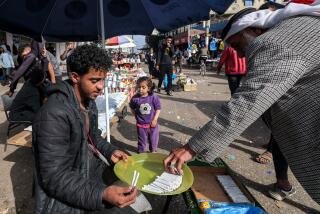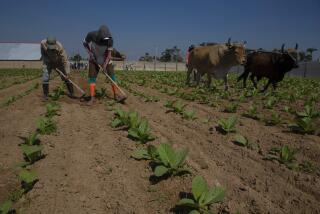Despite Recession and Oppression, Cigar Sales Soar
After years of being bad-mouthed by nonsmokers and clouded by a negative image, cigars are making a comeback, especially in the high end of the market.
“There is a whole reawakening taking place,” said Marvin Shanken, editor and founder of Cigar Aficionado, a magazine published in New York and dedicated to cigar smokers. “Cigar smokers have come out of the closet and have claimed their piece of the Earth.”
Even in the face of a lingering recession, Orange County tobacconists say, business has never been better.
“The premium cigar sales are skyrocketing,” said Jim Allison, owner of the Tobacco Barn in Lake Forest.
At the Tinder Box in Costa Mesa, sales were up 9% for 1992, owner Manjit Bain said, and this year is looking even better: Revenue rose almost 20% in January, he said, compared with the same month a year earlier.
“Cigars have been up for the last three years,” he said.
Tobacco shop owners cite several reasons for the rebound.
“What’s given cigars a bad name is the drugstore cigar,” Bain said. “A lot of people are becoming educated about how good a cigar can be.”
That may be related to the lingering image from earlier days, industry experts say, that a fine cigar is a symbol of success and power. That would explain the increase in sales of more expensive stogies. Just as likely, however, is that smokers concerned about their health are lighting up less but being more selective when they do indulge.
“With all the social pressures, people aren’t smoking as much, but they’re enjoying a better-quality cigar when they do,” said a spokesman for General Cigar Co. in Bloomfield, Conn. The company, which makes Macanudo and Partagas brands, has seen sales of its premium cigars increase 5% in each of the past three years, the spokesman said.
It’s not that premium cigars pose fewer health risks but that their cost prohibits most people from consuming very many of them, Allison of the Tobacco Barn said. “People are having two or three Davidoffs”--fine cigars that cost between $6.50 and $10.50 apiece--”instead of 50 Santa Fes,” which cost about 25 cents each.
Good cigars can go as high as $10 for hand-rolled, all-natural brands imported from the Dominican Republic, Honduras or Jamaica. Cuban cigars, considered by many to be the world’s finest, have not been allowed into the United States for years.
The cheaper brands that sell for $1 or less are generally machine-made and paper-rolled using chopped tobacco. In that price range, manufacturers and tobacconists say, sales have not changed significantly in recent years.
Allison argues that, because cigar smokers do not inhale, they face fewer health risks than cigarette smokers. But medical experts say it’s not that simple.
“Cigars are not a safe alternate to cigarettes,” said Dr. Gary Giovino of the Office on Smoking and Health, part of the National Center for Chronic Disease Prevention & Health Promotion in Atlanta. Compared with nonsmokers, Giovino said, cigar smokers have higher rates of several types of cancer, including lung, mouth and bladder.
Still, smoke-shop proprietors maintain that an occasional cigar will not cause the diseases associated with cigarette smoking.
“Cigar smokers have been kicked around for years,” said Dickson Farrington, a buyer for Alfred Dunhill in New York. “All the weak ones have died by the wayside. Everyone who’s left is pretty much an egomaniac who isn’t going to give in now.”
Farrington, whose company makes Romanas and Peravias, suggests that cigar aficionados are rebellious by nature and may enjoy challenging the notion that “you shouldn’t be smoking” but should be out jogging instead.
He also notes that the cigar industry’s advances have been spurned so far by one huge U.S. consumer group: women. “I have clients who are CEOs of Fortune 500 companies who can’t smoke in their own homes,” he said.
Some overseas markets have introduced cigars designed for women, but the trend hasn’t caught on here. “In the United States,” he said, “it’s really a male thing.”
Where There’s Smoke . . .
Smoking has been attacked during the past few years, and the recession and legislation have hampered sales. But premium cigar smokers consider themselves above the rest of the pack. Top Cigar-Consuming States
Of the top cigar-manufacturing states--Florida, Alabama, Pennsylvania and Georgia--both Florida and Pennsylvania were also among the top consumers in 1991. In millions of cigars smoked: New York: 188.2 Florida: 159.5 Pennsylvania: 154.8 Illinois: 147.6 California: 144.3 Top Exporters
Top four countries exporting premium cigars to the United States, in millions of cigars: Dominican Republic: 46.8 Honduras: 38.5 Jamaica: 6.7 Mexico: 5.9 Judging by the Cover
The outer leaf of the cigar, its most expensive part, was a $9.6-million import for the United States last year. The biggest percentage came from Ecuador. Ecuador: 27.5% Mexico: 26.5% Dominican Republic: 15.6% Indonesia: 11.5% Honduras: 11.1% Other: 7.8% Note: Other countries include Brazil, Cameroon, China, Iceland, India, Nicaragua and Spain. Cigarspeak
Using these terms will show people that you’re doing more than just blowing smoke.
Binder: Half-leaf that holds together the filler; gives a cigar its shape.
Bunch: Binder and filler rolled together. Surrounded by a wrapper to form the cigar.
Curing, fermentation: Aging processes that improve natural aroma and taste.
Long filler: Whole leaves or long strips of uncut leaves that run the length of the cigar. Generally used in premium handmade cigars. Chosen and blended for aroma, flavor and burning qualities.
Scrap: Imported cigar tobacco that has been aged and cut before it arrives. When it gets to the United States, cigar makers blend it with other imported tobaccos to make a domestic cigar.
Short filler: Cut leaves. Used in domestic cigars.
Stemming: Removal of the stem from the tobacco leaf, leaving two halves.
Wrapper: Outer leaf of cigar. It is the finest, most delicate and expensive part. Chosen for characteristics such as appearance, consistency, burning qualities and color. How a Premium Cigar Is Made
The manufacturer begins with mature, aged tobacco leaves.
1. Binder is wrapped around a filler, forming a bunch.
2. Another half-leaf called the wrapper is wound around the bunch to form a cigar.
3. Cigars are put into boxes or bundles, then aged further in a humidor, where temperature and humidity are carefully controlled. Cigar Smoke
The entire cigar-making process--from the time the leaf is cut to the moment it is smoked--takes two to three years.
More than 95% of the cigars smoked in the United States are made here.
Premium cigars are about 3% of the total market but account for about 20% of retail sales.
There were 2.2 billion cigars smoked in the United States last year, compared with 500 billion cigarettes.
Source: Cigar Assn. of America Inc. Researched by DALLAS M. JACKSON / Los Angeles Times
More to Read
Sign up for Essential California
The most important California stories and recommendations in your inbox every morning.
You may occasionally receive promotional content from the Los Angeles Times.









